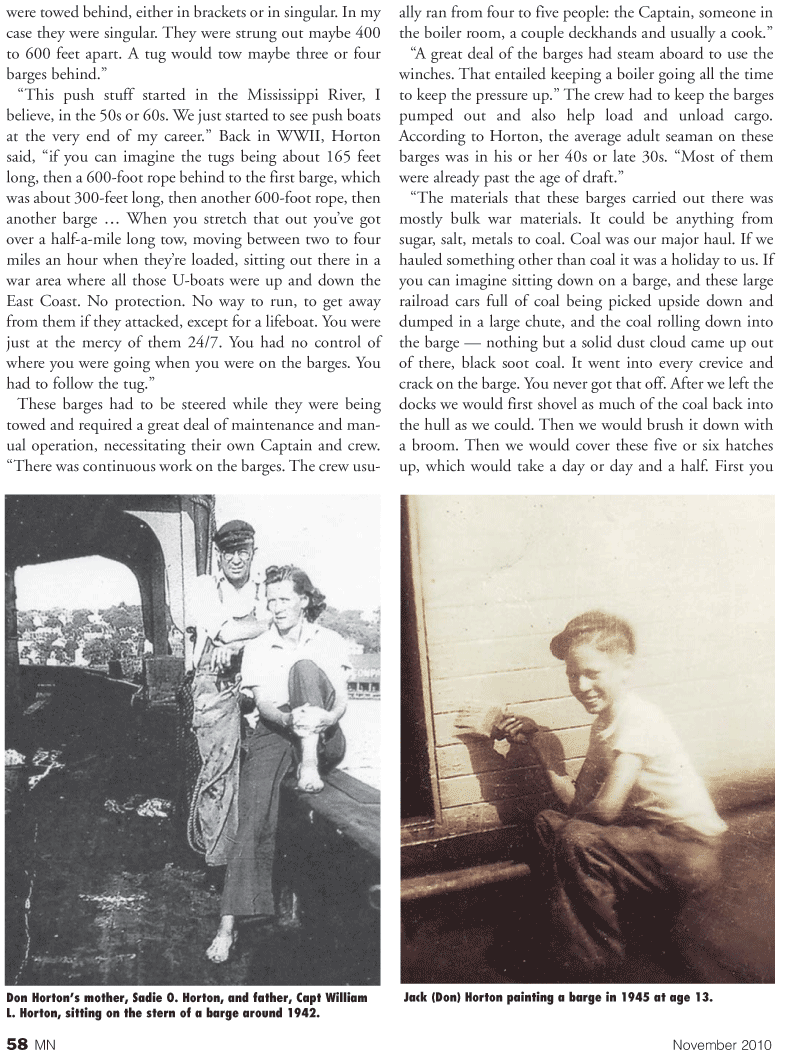
Page 58: of Marine News Magazine (November 2010)
Workboat Annual
Read this page in Pdf, Flash or Html5 edition of November 2010 Marine News Magazine
were towed behind, either in brackets or in singular. In my case they were singular. They were strung out maybe 400 to 600 feet apart. A tug would tow maybe three or four barges behind.” “This push stuff started in the Mississippi River, I believe, in the 50s or 60s. We just started to see push boats at the very end of my career.” Back in WWII, Horton said, “if you can imagine the tugs being about 165 feet long, then a 600-foot rope behind to the first barge, which was about 300-feet long, then another 600-foot rope, then another barge …. When you stretch that out you’ve got over a half-a-mile long tow, moving between two to four miles an hour when they’re loaded, sitting out there in a war area where all those U-boats were up and down the
East Coast. No protection. No way to run, to get away from them if they attacked, except for a lifeboat. You were just at the mercy of them 24/7. You had no control of where you were going when you were on the barges. You had to follow the tug.”
These barges had to be steered while they were being towed and required a great deal of maintenance and man- ual operation, necessitating their own Captain and crew. “There was continuous work on the barges. The crew usu- ally ran from four to five people: the Captain, someone in the boiler room, a couple deckhands and usually a cook.” “A great deal of the barges had steam aboard to use the winches. That entailed keeping a boiler going all the time to keep the pressure up.” The crew had to keep the barges pumped out and also help load and unload cargo.
According to Horton, the average adult seaman on these barges was in his or her 40s or late 30s. “Most of them were already past the age of draft.” “The materials that these barges carried out there was mostly bulk war materials. It could be anything from sugar, salt, metals to coal. Coal was our major haul. If we hauled something other than coal it was a holiday to us. If you can imagine sitting down on a barge, and these large railroad cars full of coal being picked upside down and dumped in a large chute, and the coal rolling down into the barge — nothing but a solid dust cloud came up out of there, black soot coal. It went into every crevice and crack on the barge. You never got that off. After we left the docks we would first shovel as much of the coal back into the hull as we could. Then we would brush it down with a broom. Then we would cover these five or six hatches up, which would take a day or day and a half. First you
Jack (Don) Horton painting a barge in 1945 at age 13.Don Horton’s mother, Sadie O. Horton, and father, Capt William
L. Horton, sitting on the stern of a barge around 1942. 58 MN November 2010

 57
57

 59
59
